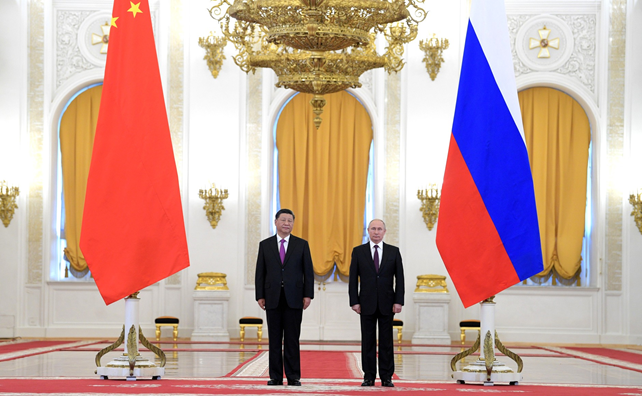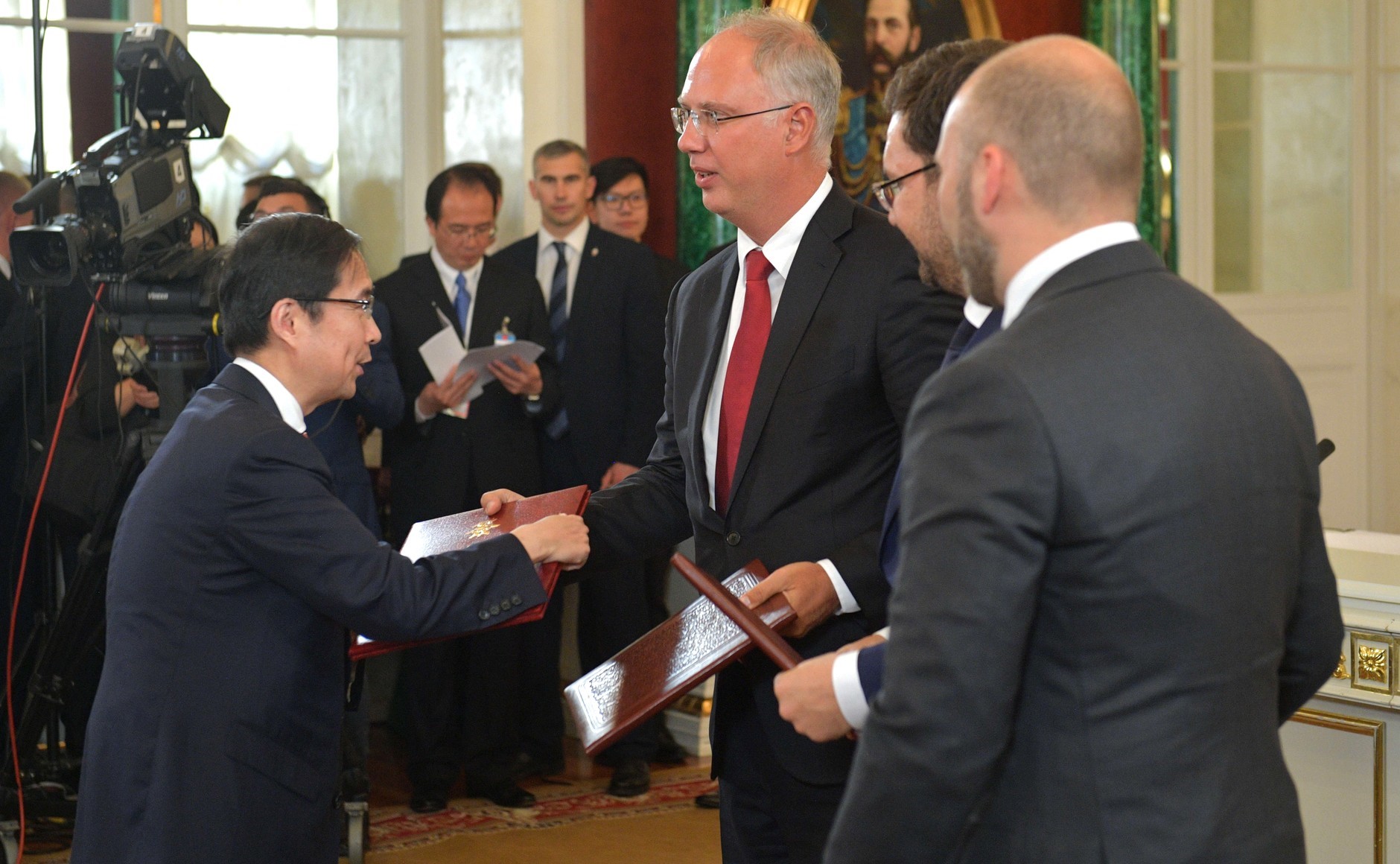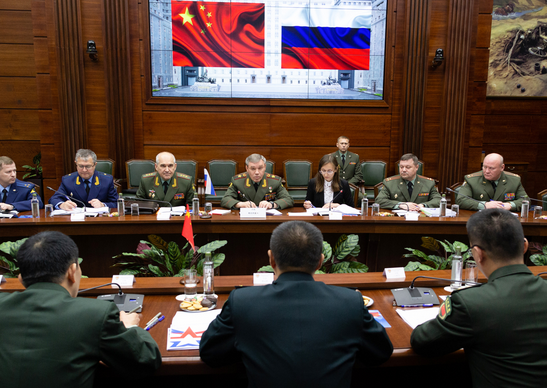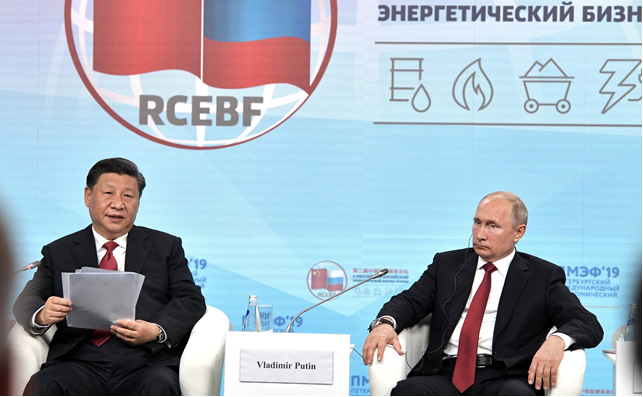SPECIAL REPORTS
Date: 27 June 2019
Chinese-Russian Unequal Partnership
The gaps and discrepancies between China and Russia are so weak that both countries do not see themselves as competitors. However, all disparities in Moscow’s and Beijing’s interests are an obstacle to the two states’ lasting and durable alliance while imposing the construction of a new model of a “system of great states”. What brings Russia and China together is their rivalry with the United States. But what is important is that how diversified this rivalry turns out, with Russia competing at the political and military level and China – mostly economic and trade. This difference comes a long-term factor to influence Beijing’s cooperation with Moscow.
- Being far way weaker that during its Soviet times, Russia accepted China’s new role in the world and is at the same time ready to acknowledge its own position as a younger partner. Moscow and Beijing have formed a peculiar alliance that shows both coherence at the global level and regional competitiveness. And Putin is sacrificing his country’s long-term position to gain current and short-term benefits for his regime, running the risk for Russia of becoming China’s energy attachment.
- Russia has held more interest in strengthening its cooperation with China for at least five years, but Beijing seemed distanced towards all attempts to give their informal agreement a far more standardized character. The Middle Kingdom has in recent months engaged in cementing ties with Russia because it is now waging a trade war with the United States and tensions are mounting in the waters off China. A détente in China-Russia relations will automatically cool off the former’s approach towards the Kremlin’s aspirations to become an ally.
 Xi Jinping and Vladimir Putin in the Kremlin. Source: kremlin.ru
Xi Jinping and Vladimir Putin in the Kremlin. Source: kremlin.ru
Of these two, Moscow is undoubtedly making way more intensified efforts to tighten bilateral cooperation or even to build a Sino-Russian alliance. The weakening Russian Federation eyes its partnership with the Middle Kingdom as the recipe for Washington’s global domination that, according to the Kremlin, can be referred to as the primary source of Moscow’s political, military and economic problems. Russia began to speak out about setting a coalition with Beijing shortly after it had become aware of the failure of its reset policy towards the United States.
To make matters worse, Vladimir Putin suffered a real defeat in Libya, with NATO’s armed intervention that led to the ouster former of strongman Muammar Gaddafi, the Syrian “Arab Spring” made the country slide into a civil war while Russian people gathered in the streets of Moscow and St. Petersburg in the winter of 2011 and 2012 for what was called as biggest rallies against the Russian authorities since Putin came to power. Russia’s incumbent president, who served as Russia’s prime minister at that time, accused Washington of attempting to trigger off a “color revolution” in Russia. As a presidential candidate, Putin wrote in February 2012 in one of the newspapers that “China’s economic growth is by no means a threat, but a challenge that carries a chance to catch the Chinese wind in the sails of our economy.” Shortly after being re-elected, Putin paid his first foreign visit to Beijing, marking a symbolic tilt towards China. But Beijing was in no hurry to cement its ties with Moscow. Back then, Obama was still the U.S. President, and China felt satisfied with his policy and its own possibilities of economic expansion on American soil. After a meltdown in Russia’s relations with the West in 2014, Beijing grew excessively cautious in its relations with Moscow. In March 2015, Fyodor Lukyanov, the chair of the Council for Foreign and Defense Policy and a political commentator close to the Kremlin, wrote for the German weekly Die Welt an article under the telling title If the Russians and Chinese March Together, in which he outlined a vision of a close Sino-Chinese alliance in the fields of economy, politics and security. There is still a long way to implement this vision, referred to as longed-for by Vladimir Putin, but Russia and China have anyway held the closest ties since the 1950s.
Xi in Moscow: “Strategic Partnership”
In early June, Chinese president paid a high-profile state visit to Moscow. This has been Xi’s eighth trip to Moscow since he took office in 2012. But the bonhomie between Xi and Putin seem best evidenced by the fact that both leaders have met almost thirty times. But that is not the reason behind Xi calling Putin his “close friend” as Beijing for the first time in a long time cared as much about their meeting as Moscow did.
The delegation’s talks were attended by Russian deputy prime ministers, ministers and chiefs of the largest corporations. Also, China sent his senior officials to take part in the forum. Putin’s foreign policy aide, Yuri Ushakov, said before the visit that Chinese firms are involved in developing up to 30 investment projects in Russia, worth a total of $22 billion and the increasing trade grew by 25 percent in 2018 to hit a record $108 billion.
Focused chiefly on economic matters, the June summit was intended to deepen cooperation between the two countries in the energy, aviation and communications sectors, as well as to open up new opportunities in areas such as agriculture, finance, technology and e-commerce.
Major Russian and Chinese firms inked thirty cooperation agreements. Much attention was drawn to a memorandum signed by Russian telecoms company MTS and Chinese Huawei on building 5G Internet in Russia. But Moscow should become well aware of this China’s cutting-edge technology gift having been offered after Huawei found itself in a deep defensive on markets worldwide, with the United States fighting a battle against this China-based telecoms giant. Besides, Chinese e-commerce giant Alibaba signed an agreement with Russia on creating a new company AliExpress Russia. The deal was closed by China’s Alibaba, Russian mobile phone operator Megafon, internet group Mail.ru and the Russian sovereign investment fund RDIF. And Russia’s Novatek and Gazprombank signed an agreement with Sinopec to market gas in China. Russia’s Economic Development Minister Maksim Oreshkin and China’s Science and Technology Minister Wang Zhigang inked a deal to establish a research and technology innovation fund worth some $1 billion. It will be financed by the Russian Direct Investment Fund and the China Investment Corporation.
 The agreements exchange ceremony during Xi Jinping’s state visit to Russia. Source: kremlin.ru
The agreements exchange ceremony during Xi Jinping’s state visit to Russia. Source: kremlin.ruAll these agreements were only possible thanks to the political decision of Beijing, whose trade war with the United States is heating up.
In general, Chinese entrepreneurs and state-run companies remain quite reticent about investing in Russia, especially in its financial sector, mainly due to the risk of imposing sanctions.
To mask these shortcomings, Putin spoke against the domination of the U.S. dollar as the world currency, calling the American pressure on Huawei “the first technological war of the digital age.”
This coincided with an incident in the East China Sea when a Russian navy destroyer Admiral Vinogradov had a near miss incident with a U.S. navy warship, the U.S.S. Chancellorsville, and the Russian government tried to accuse Washington of what had happened, marking in this manner an anti-American character of its rapprochement with China. Beijing and Moscow have been brought closer by the United States, their common enemy. The U.S.-Russian relationship deteriorated somewhat after Moscow’s aggression in Ukraine in 2014 while Donald Trump’s coming to power ignited (mostly) economic rivalry between the United States and Beijing. As Putin assured, the “strategic partnership” between Moscow and Beijing has reached an “unprecedentedly high level” while Xi Jinping,
when speaking about the stable development of Sino-Russian relationship, admitted that the two countries remain committed to “firmly supporting one another and defending their vital interests.” Putin said after meeting Xi in the Kremlin that Russia and China hold convergent views on most international issues. For instance, Putin reiterated that Moscow and Beijing share opinions on the U.S. pullout from the INF Treaty. Coincidentally, as for almost all of the burning international matters, the two capitals are on the opposite side of the barricade than the United States.
NEWSLETTER
Not Yet (?) an Alliance
Cooperation between the Russian Federation and the People’s Republic of China has hit its highest point since the two countries signed a friendship and cooperation treaty in 2001. Putin’s regime had never eyed China as its enemy yet Moscow’s long-lasting priority, inherited back from the Yeltsin era, was to encourage cooperation with the West, with particular regard to Europe. This all changed after Putin embarked on a confrontational course against the West while the United States became aware of the dangerously growing potential of China that went far beyond economic issues. Although Putin declared his much-trumpeted “Asian pivot” after beginning his third term in office, Russia has consistently encouraged the narrative of “privileged strategic partnership” with Beijing since 2014. But the real cooperation gained momentum after the two countries had concluded a grand gas deal and Moscow’s relationship with the West dramatically decayed after the former had invaded Ukraine. China became a top priority for Moscow and Beijing has engaged in forming a Eurasian strategy, with Russia as its crucial element. Besides the access to cheap energy supplies, close ties with China’s weaker neighbor offer Beijing an opportunity to develop its investments and political influence in the region and, most importantly,
strengthen its position against Washington. Also, Moscow is close to Beijing’s position on regional security issues.
The security aspect is becoming stronger than ever before as it has never been of particular importance, giving way to Russia’s and China’s shared criticism of the United States and their bilateral energy partnership.
In China’s eyes, Russia’s invasion of Ukraine and the annexation of the Crimean Peninsula breached the two core principles of foreign policy that consisted in not meddling in other state’s domestic affairs and counteracting separatist moods. But Beijing eventually waved it aside, with the conflict between Russia and the West being to its liking, distracting Washington’s attention from the Pacific and eventually pushing Russia into the Chinese grip. Xi Jinping intends to earn an ally on a continental foothold in the face of mounting tensions in eastern Asia whose countries fell back on the U.S. aid, fearing Beijing’s territorial claims. Moscow took China’s side in all these disputes, yet it cannot count on its partner’s reciprocity in the case of Crimea and Ukraine. At the G20 Summit in the city of Hangzhou in September 2016, Vladimir Putin endorsed China in the critical Asian territorial disputes by openly and unequivocally backing Beijing’s stance on the South China Sea. Also, he declared his support for territorial claims, demands on Washington to stay out of the waters and rejected a ruling of the international tribunal. Never before had any representative for Russia voiced such solid support for China’s position towards ASEAN countries (including Vietnam that buys Russian-made weapons) and the United States.
Still the same month, a fleet of Russia and Chinese ships sailed out at sea to hold naval drills off China’s Guangdong province. The war games involved naval vessels, submarines, aircraft, and helicopters while its scenario encompassed aerial assault as well as occupying and defending the islands. These joint military maneuvers marked China’s and Russia’s largest naval operation ever carried out and confirmed ever-tightening military cooperation between the two countries. Also, they came shortly after the Chinese government had dismissed the international arbitration ruling in a territorial dispute with the Philippines, claiming the right to some 85 percent of the basin. Once deployed to the area, Russian warships sought to demonstrate the Kremlin’s stance. In July 2017, Chinese warships arrived in the Baltic to start China’s first naval exercises with Russia in the region.
In an annual worldwide threat assessment published in January 2019, U.S. Director of National Intelligence Dan Coats said that “China and Russia are more aligned than at any point since the mid-1950s.” Back in November 2014, Russia openly suggested that China form a military alliance, with Defense Minister Sergei Shoigu and his deputy Anatoly Antonov speaking about the joint fight against terrorism and “color revolutions.” However, a closer security approach would not be possible if such an axis had recently not exposed to the increasingly fertile ground in China whose foreign policy is becoming both expansive and globally oriented.
And yet, compared to the diplomatic and economic aspects, the military side of the Russian-Chinese partnership is still weak, preventing Moscow and Beijing from forging an alliance. Also, the participation of Chinese armed forces in the Vostok 2018 military training activities should not be overestimated. While Russia deployed up to several hundred thousand troops and up to 1,000 warplanes, China sent some 3,200 servicemen and six aircraft. A fog of propaganda was also created around Chinese purchase of the new generation of Russian S-400 air defense missile systems. But there are also some other countries, including Turkey, India (Russia’s old enemy), Qatar and Saudi Arabia, waiting in line. China was indeed the first country to buy Russia’s most advanced Sukhoi Su-35 fighter jet. But it is not the only one to have taken this step. Indonesia so far has procured 11 Su-35s, Egypt has bought even more of them, while India plans to acquire 114 combat aircraft. As for armaments cooperation, between 2013 and 2017, India was a far likelier destination for Russian-made weapons, accounting for 35 percent of total Russian arms exports, than China (12 percent). Once Beijing purchased S-400s and Su-35s from Russia, nothing is known about any forthcoming armaments deals between the two countries
It is noteworthy that Russia and China have long remained close allies within the United Nations Security Council, with Beijing’s leading role in the North Korean nuclear program and Moscow having the decisive voice in the Syrian issue. China and Russia share a viewpoint on Iran’s nuclear program, lambasting the U.S. decision to withdraw from its deal with Tehran and impose stricter sanctions against the country. When a Chinese delegation paid a visit to Moscow at the end of 2013, Chinese Deputy Foreign Minister Cheng Guoping said that China and Russia “agree entirely with each other’s positions” on the policy towards Syria and North Korea. And a similar consensus can also be seen in other hot spots in the world, from Myanmar and Iran to Venezuela and Cuba. The Beijing-Moscow axis has become the center of a geopolitical constellation bringing together bloody dictatorships, totalitarian regimes and corrupt satrapies. Among them are Iran, Syria, North Korea, Myanmar, Zimbabwe, Sudan, Venezuela, Cuba, and Nicaragua, all of which can count on the diplomatic aid from Moscow and Beijing. The former is the leading arms supplier while the latter fulfills the role of a generous lender, investor and raw materials recipient.
 Chief of the General Staff of the Armed Forces of Russia and Chinese commanders discuss bilateral cooperation. Source: function.mil.ru
Chief of the General Staff of the Armed Forces of Russia and Chinese commanders discuss bilateral cooperation. Source: function.mil.ru
Raw Material Attached
In its relations with Russia, China privileges the economic factor, benefiting from easy access to energy resources right by the border. Russia boosts its oil export to China while gas shipments are expected to increase after the Power of Siberia energy pipeline becomes operational. But both sides have been making bids to depict their economic cooperation as more diversified. Moscow is keen on Chinese investments and capital, and Beijing is thus trying to show that it has alternatives to the U.S. market at the highest point of its trade war with Washington.
In consequence, this year’s edition of the St. Petersburg International Economic Forum, a platform that usually served to attract Western investments, was devoted to showing friendly and ever-growing ties between Russia and China. Xi Jinping was the guest of honor at the annual event, where he arrived after hours-long talks with Vladimir Putin.
Support Us
If content prepared by Warsaw Institute team is useful for you, please support our actions. Donations from private persons are necessary for the continuation of our mission.
Having already mentioned bilateral economic agreements inked during Xi’s three-day trip to Russia, it is noteworthy that Moscow holds in general bigger in developing economic ties with the Middle Kingdom, seen as a counterweight to Western domination on global markets, including currency ones. So the Russian central bank tripled the state’s foreign reserves, of which it now holds 15 percent in yuan while Russia and China prefer not to use U.S. dollars in their bilateral financial settlements. The Kremlin’s desire to move closer to Beijing is illustrated by how it shifted its stance towards China’s Belt and Road initiative.
Earlier, Russian had viewed the project as competitive to the Moscow-dominated Eurasian Economic Union (EAEU). While visiting Beijing in April 2019, Vladimir Putin backed China’s Belt and Road project despite concerns raised by some Russian politicians claiming that the undertaking will narrow down Moscow’s influence across the continent.
According to Putin’s foreign policy aide, Yuri Ushakov, China-Russia bilateral trade came to its highest in 2018, as exemplified by the continuous annual growth in its value. The trade turnover between Russia and China in 2012–2013 amounted to $89 billion. In 2014, it rocketed to $95 billion, marking a sixfold increase compared with 2003. Also, China came second as the biggest external financing source for real sectors of the Russian economy ($13.6 billion). In May 2015, Beijing and Moscow announced that their trade turnover would rise to $100 billion in 2015 and $200 billion in 2020. But these forecasts proved too optimistic, given the slowdown in 2015, then followed by a slight increase. In 2016, the trade turnover between the two countries amounted to $70 billion while $84 billion in 2017. And it rose last year to $108 billion. So is this the foundation of Moscow’s alliance with Beijing? Not really. The same year saw trade exchange between China and Vietnam amounting to $148 billion, with which Beijing cannot boast of such friendly ties as it has with Moscow. Besides, the increase in the value of Russian trade with China in 2018 resulted mainly from a healthy boost in Russian oil imports through China in Beijing’s effort to search for alternatives to Iranian oil. China remains Russia’s top trading partner while Russia ranks tenth of all Chinese partners, with the United States in the lead. More than 75 percent of Russian exports to China are raw materials, with particular regard to crude oil, wood and coal. China’s sales to Russia are 45 percent consumer goods and 38 percent electronics and machinery. Once launched, the Power of Siberia gas pipeline will further widen the disparity in their trade structure. Their situation resembles a relationship between a metropolis and a colony and the former are rather unlikely to forge an alliance with the latter unless their deal is based on a significant disparity of their status.
So what is the development of economic cooperation like after Russia’s famous tilt towards China in 2014? Between 2014 and 2018, China’s direct investment in the Russian economy did not surpass the amount of $24 billion. The same period saw Beijing’s money flows of $148 billion to Sub-Saharan Africa, with $31 billion to Nigeria, and of $88 billion to South America, where it allocated the sum of $34 billion in Brazil alone. Of a large group of joint projects discussed by Russia and China over the past fifteen years, only a handful managed to be finally implemented. Among them was a medium-size oil pipeline, for which Russia’s Transneft and Rosneft secured $25 billion from Beijing in upfront payments. China’s Sinopec got a few oil deposits by the Volga River and Chinese sovereign wealth fund CIC acquired shares in Uralkali, the world’s largest potash producer. In 2009, Chinese President Hu Jintao and Russian President Dmitry Medvedev signed the Program of Cooperation in the regions of Far East, Russian Eastern Siberia, and Chinese North-East in 2009–2018. The joint initiative contained a list of 91 investment projects, of which China managed to bankroll only eleven six years after the deal had been sealed. The remaining initiatives have never been introduced. Also, CEFC China Energy’s plan to buy a 14 percent stake from Rosneft ended in failure. Being perfectly aware of their stronger position, Beijing is in no hurry to engage in economic cooperation and seems interested in entering some specific sectors in the Russian market yet on its own terms. China sees its neighbor’s economy deteriorating and the Kremlin falling short of any anti-crisis strategy. In August 2015, a senior official of the Chinese Trade Ministry Ling Ji said that the fall in oil prices and the volatility of the Russian currency pose an additional risk to Russian-Chinese cooperation. China knows well that Russia needs further investments and financing in the face of low oil prices and isolation from the West. And this is why the Middle Kingdom can dictate conditions to Moscow. China reached a deal to lend $25 billion to the Power of Siberia energy project whose total cost is estimated at $55 billion. The planned gas pipeline of a full annual capacity of 38 billion cubic meters is for Beijing only a part of its energy import diversification plans. As for now, China buys gas from Australia, Qatar and Turkmenistan.
The economic relationship between the two countries cannot be referred to as equal, with the Chinese economy growing eightfold compared to the Russian one and developing at a more excellent pace. According to the World Bank, China’s gross domestic product in 1992 was slightly smaller than Russia’s ($427 billion versus $460 billion).
A quarter-century later, in 2017, it was nearly eight times as large ($12.2 trillion versus $1.6 trillion). China’s growth rate remains over four times that of Moscow’s – a divergence that ensures that the imbalance between their economic potential.
In fact, Russia supplies raw materials and unprocessed products to China – Moscow became China’s largest supplier of crude oil in 2016, displacing Saudi Arabia – and is a far less attractive market. And this is certainly not an alternative to the Western suppliers. China is not capable of replacing Europe as an outlet for Russian-sourced energy resources. And even if both planned pipelines become operational to pump gas from western and eastern Siberia, their total capacity will not surpass annually 78 billion cubic meters by 2020. Even if the price of gas shipped via Power of Siberia will be similar to the one paid by Germany – although it is said to be lower after deducting construction and loan costs – China will be keen to pay no more than what it already does for Turkmenistan in the Western direction, which is way much lower than what Russia gains in Europe.
Sino-Russian Limited Liability Alliance
The economic aspect of Russian-Chinese cooperation shows to the greatest extent how unequal their relationship is, of course, to the detriment of Russia.
So Moscow longs for this deal much more than Beijing does, using its best efforts to avoid conflicts, make concessions and play on time, with the last solution adopted with regard to issues such as gas cooperation or the role of the Shanghai Cooperation Organisation. All this marked a shift in the attitude of the Kremlin that a decade ago saw Beijing as its younger partners. Today’s reality is completely different. A classic full-fledged alliance between China and Russia is doomed to fail, because it bases upon solely on their rivalry with Washington, yet viewed differently in Moscow and Beijing.
There are many gaps between the two countries.
Russia and China are to a great extent divided by a several factors, including their rivalry in the Arctic and the North Pacific, the two regions that Russia seeks to guard against competitors, all the more so that China has a growing polar appetite, as well as selling Russian weapons to Vietnam and India, the latter eyed by Beijing as its implacable enemy. Moscow is also afraid of China’s feasible intention to populate the Russian Far East in a move justified by the latter’s historical claims. But Central Asia remains the most direct area of Sino-Russian rivalry. Turkmenistan ranks fourth in the world in terms of natural gas reserves, while Kazakhstan – twelfth.
Their gas exports to Russia have dropped by 60 percent since the energy pipeline to China became operational in 2009. Access to Turkmen or Kazakh-sourced energy equips Beijing with a stronger position in talks with Russia. It is China, and not Russia, that has emerged as the largest trading partner for each of the five former Soviet republics: Turkmenistan, Uzbekistan, Kazakhstan, Kyrgyzstan and Tajikistan. Also, Russian and Chinese economic interests diverge in the context of the economic integration of the post-Soviet area. While Beijing prefers to conduct separate trade with Kazakhstan, Belarus or Russia, the goal of the Eurasian Economic Union (EAEU) is to create a single internal trade market in a step that may exert a negative influence on Chinese exports. Further tensions between Moscow and Beijing are mounting around the Shanghai Cooperation Organisation, with the former interested in preserving a military and security character of the initiative while the latter hoping to transform the organization is a far more multilateral organism and a tool to expand economic influences in the former Soviet republics.
China has failed to support Russia in matters of great geopolitical importance to Moscow. Beijing refused to recognize the independence of Abkhazia and South Ossetia after the Russian-Georgian war in 2008.
Also, Chinese ambassador abstained from, instead of voting against, the U.N. resolution condemning Russia’s 2014 seizure of Crimea. When Chinese President Xi Jinping first announced his flagship Belt and Road Initiative in 2013, he chose to do so in the Kazakh capital of Astana, marking a symbolic yet unpleasant step for the Kremlin. And although Xi and Putin agreed in May 2015 to “coordinate cooperation” between the Moscow-dominated Eurasian Economic Union and the China-led Belt and Road initiative, Chinese initiatives in Central Asia are doing much better than the Russian ones. Beijing remains reticent of Russian attempts to normalize relations with Japan, known as China’s bitter rival.
The Shanghai Cooperation Organization summit saw tensions between the two countries. First, Russia invited India – China’s fierce enemy – to join the meeting. For its part, China extended the invitation to Pakistan, India’s enemy and the largest buyer of China-made weaponry. After a round of high-profile talks in 2015, the Kremlin decided to buy from China’s telecoms giant Huawei data storage systems and Internet content-filtering systems. But Russia suddenly withdrew from the business: Russian special services, well aware of the risk of Chinese espionage, told the Kremlin to pull out from the venture.
The main problem of Sino-Russian is, at least according to the Russian public opinion, somewhere else. After the Shanghai summit in May 2014, a 1950s style poster showing Putin and Xi, who resembled Joseph Stalin and Mao Zedong, under the slogan Our Crimea – Your Siberia, caused a stir in the Russian-speaking Internet. Many Russian politicians still scare society with China’s colonization of eastern Siberia. Although this is in no small extent a historical issue, swept by the Russians under the rug, it may have a decisive impact in the future. And Beijing shows that it has still a living memory of the Treaty of Aigun in 1858 with Russia. As part of the agreement, Russia received all land on the left bank of the Amur River and
China got to keep the right bank as far as the Ussuri River.
The Ussuriisky Region remained under the joint jurisdiction of both countries.
Most Chinese historians consider the Treaty of Aigun, along with the Treaties of Peking and Tientsin, inequitable, saying that a strong Russia forced a weak China to accept an unfair agreement. Interestingly, the town of Aigun later got a completely different name, with Russia using the name of Zabaikalsk, and China – Heihe. But in 2015, the historical name of Aigun was eventually restored and Beijing sought to show that Russia had in the past stripped China of a vast area in the Far East, with the Treaty of Aigun serving as a symbol of Russian expansion. Restoring the old name sparked a wave of euphoria among members of the Chinese nationalist milieu that are insisting on Moscow to issue a public apology for the policy of tsarist Russia towards China. This is the first step to call for the return of territories in the region. And interestingly, China’s official authorities have not taken a position in this matter, nor they have made attempts to make “revisionists” shut their mouth, and the latter solution can be swiftly adopted in the communist regime. And nationalist movements such as Baodiao could not function freely without consent from the authorities. China’s historical memory serves as a salient aspect of national consolidation drawn from its negative past experiences, referring mostly to the legacy of the “century of humiliation,” the period between the beginning of the Opium Wars and the founding of the People’s Republic of China. Among the countries that humiliated the weak Middle Kingdom back then were the United Kingdom, France, Germany, Japan, the United States and – also – Russia.
Over the past 25 years, Russia has offered to lease to China as much land as Beijing had not been capable of conquering for the previous 150 years. Chinese expansion of the Asian part of Russia, mainly in the Russian Far East, is at least for now referred to as a classic example of settlement. Chinese people arrive in the area temporarily to work and are employed by Chinese businessmen. Beijing speaks almost exclusively about business and economy, which comes as a convenient solution for both local elites and Moscow – as, under Putin’s strategy, China can be neither a rival nor an enemy. But the second step will take place sooner or later, meaning demographic and ethnic changes in the structure of the population inhabiting the Russian Far East. Chinese authorities are carefully planning a big jump to the other bank of the Amur River, as exemplified by their recent decision to allow citizens living in the regions bordering Russia to have up to three children, against a two-child policy applied throughout the country. This will contribute to intensifying China’s expansion onto depopulated areas of the Russian Far East.
Chinese Older Brother
Xi Jinping’s visit to Moscow, hailing Putin as his “best friend,” signed cooperation agreements and China’s active participation in the St. Petersburg International Economic Forum failed to mark the beginning of the Sino-Chinese alliance. This is by no mean equivalent to launching a new stage of their mutual cooperation, mostly due to the lack of military or security components. Not incidentally, all deals so far sealed by Russia and China refer to economic issues, with all benefits will be reaped by state and private companies holding close ties to the Kremlin while showing that China and Russia are able to unite their forces when facing economic conflicts with the United States (trade war and sanctions respectively) to narrow down all adverse effects of Washington’s policy. The first category of Russian-Chinese deals seems best illustrated by Sinopec’s participation in Sibur’s construction project or an agreement concluded between Russia’s Novatek and state-run lender Gazprombank, and their Chinese partners on sending LNG supplies to Beijing, whereas the latter category refers to joint telecommunications cooperation, as exemplified by China’s Huawei planning to build 5G Internet in Russia. Instead of the military partnership, Moscow would seem far more interested in rapprochement with Beijing, with Putin repeatedly – and much more often than his Chinese counterpart – saying about an alliance between the two countries, which is, of course, not at all true. Beijing sees Russia as a source of energy resources to which it referred to as safe due to its geopolitical location, pro-Chinese stance of Russian elites, high vulnerability to corruption among Russian officials, or extensive influence within the Russian presidential administration enjoyed by oligarchs and CEOs of large corporations, who have long eyed Moscow-Beijing cooperation as an opportunity to earn billions of dollars. Handling vast state-owned projects, with the Power of Siberia energy pipeline at the forefront, brings considerable benefits to private-run subcontractors owned by the Rotenberg brothers, Timchenko, Mikhelson or Kovalchuk. Not incidentally, of all agreements concluded so far, one stipulates for opening up China’s market for Russia’s private-run gas giant Novatek.
Either bilateral deals or what has been said about common interests in different parts of the world or geopolitical issues do by no mean change Russia’s relations with China, with Moscow dubbed a younger and less significant partner, albeit the Kremlin seems to have used to this state of affairs. A demonstrative rapprochement between China and Russia has yet a short lifespan and is owed to strains in both countries’ relationship with the United States. The current state of their mutual cooperation, along with further prospects, will exert no impact on what is taking place now, with the United States being a key economic partner for China and the European Union for Russia. Russia uses Xi Jinping’s visit to Moscow as a bargaining chip against Washington while Vladimir Putin has made efforts to show that Russia is not at all isolated and it aspires to tighten its military ties with China in a bid to solidify its status toward NATO and the United States. But Beijing seems unlikely to build a military alliance with Moscow, instead opting for entering into cooperation with the United States and not at all risking destroying mutual ties with Trump with any joint military efforts with Moscow. And China has managed to expand its military buildup so it will no longer need Moscow’s help in the event of a regional conflict, especially in the Pacific area. The same applies to possible armaments supply deals as such large contracts used to help China develop its own production and technologies. Today the situation is quite different, but if Beijing intended to buy weapons from Russia, it would hope to acquire cutting-edge defense technologies as other seem less attractive, and China has already at its disposal more advanced military solutions. But Moscow has no intention to sell off its best and newest weapons abroad, so it is not to be expected that the two countries will soon develop their armaments partnership.
 Russian President Vladimir Putin and his Chinese counterpart Xi Jinping at the Second Russian-Chinese Energy Business Forum. Source: kremlin.ru
Russian President Vladimir Putin and his Chinese counterpart Xi Jinping at the Second Russian-Chinese Energy Business Forum. Source: kremlin.ruAnd if Beijing and Moscow choose to cement their further cooperation, they will both intended to do so through an economic alliance, with particular regard to Russian-sourced hydrocarbon supplies, including LNG, flowing to China. This entails further changes in directions of liquefied natural gas export from the United States because Washington finds it little profitable to sell its energy to Asia and prefers to increase gas volumes shipped to Europe. China needs to fill this gap with imports of Russian-sourced energy. And the energy industry is the other sector where cooperation may quickly develop. This is mainly about China’s involvement in the exploration of Arctic resources and its participation in constructing the Northern Sea Route, a Russian large shipping lane. Speaking at a meeting of the Arctic Council, U.S. Secretary of State Mike Pompeo sharply criticized Beijing’s ambition in the Far North.
Naturally, the U.S.-Chinese trade war has worked out well for Russia, bringing Beijing closer to Moscow. Russia has less to lose in the event of a global crisis or even a severe armed conflict. While its economy is developed to a lesser extent and weakly tied to the worldwide economy, the Kremlin may be more likely to spark provocations. China, with its world’s second-largest economy and almost eight times bigger than the Russian one, could ill afford to perform similar activities. The country exports cutting-edge telecoms technologies, telephones, computers and cars while its trade with the United States and the European Union is five times greater than that with Russia. Due to its greater interdependence with other leading world economies, the Chinese system is much more sensitive to geopolitical turmoil than the Russian one.
China, which benefits from the worldwide liberal economic order much more significantly than Russia, is then less likely to alienate the United States and will not opt for opening a clash with its Western partners. Instead of doing so, it will prefer to employ cooperation with Russia as part of its geopolitical game against Washington. Under Trump’s administration, Putin has made several yet failed attempts to warm up or even reset U.S.-Russian relations. The Kremlin is aware of the fact that events such as Xi Jinping’s visit to Russia and inking bilateral agreements with China may, in consequence, deteriorate U.S.-Russian ties. Beijing, for its part, is capable of impeding further rapprochement with Russia at any moment in case there is a breakthrough in relations with Washington. To put it short, Russia runs the risk facing a tactical rapprochement with China because it simply has no other choice. China has such an alternative and there is no doubt that if the country ever has to choose between proper relations with the United States and an alliance with Russia, it will surely opt for the former option.
The publication of the Special Report was co-financed from the funds of the Civic Initiatives Fund Program 2018.
The concept of analytical material was created thanks to co-financing from the Civil Society Organisations Development Programme 2019.
Selected activities of our institution are supported in cooperation with The National Freedom Institute – Centre for Civil Society Development.
All texts published by the Warsaw Institute Foundation may be disseminated on the condition that their origin is credited. Images may not be used without permission.

















